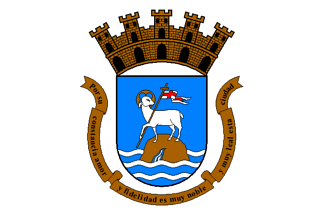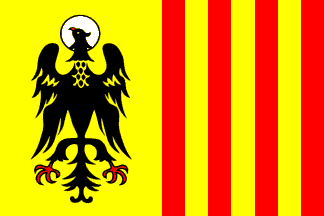Sanctus Petrus et Sanctus Paulus, or pro nobis
Friday, June 29, 2012
Santos Pedro y Pablo
Sanctus Petrus et Sanctus Paulus, or pro nobis
Tuesday, June 26, 2012
San Josemaría
Stir up that fire of faith. Christ is not a figure that has passed. He is not a memory that is lost in history. He lives! 'Jesus Christus heri et hodie, ipse et in saecula', says Saint Paul. — 'Jesus Christ is the same to-day as he was yesterday and as he will be for ever'. - The Way, St. Josemaría Escrivá
Sanctus Iosephmaria, ora pro nobis
Monday, June 25, 2012
Monday Moped
Because it's Monday and mopeds are cool... 1980 Tomos A3 Bullet
 |
| Photo from Myron's Mopeds |
Now, for some entertainment.
It needs some cowbell I think.
Sunday, June 24, 2012
More Vexillogical and Heraldic Musings, Tied to Today's Solemnity
Once again I muse about the vexillology and heraldry of Puerto Rico. The island was discovered by the Europeans on Christopher Columbus's second voyage. He named the island San Juan Bautista "Saint John the Baptist". That was the islands name until it got switched with the town of Puerto Rico, thus making the municipality and city of San Juan.
San Juan's flag, which is just the Coat of arms on a white background
According to Municipal Legislature of San Juan, on the coat of arms you have the Paschal Lamb, which represents Christ. This also represents St. John the Baptist who said of Jesus, "Behold the Lamb of God, who takes away the sin of the world." The rock that the Lamb is on has two meanings, one is it's representation of Mt. Zion, symbol of the holy city of Jerusalem and the Church. The second meaning is it's representation of the the islet of San Juan. The stream represents the rivers of Paradise and the Sacraments, particularly Baptism. The mural crown with the five towers signifies San Juan as a city. The motto translates to "For her constancy, love and fidelity, this city is very noble and loyal."
That covers the city/municipality, now for the island. As I stated in my last post about flags and stuff every municipality in Puerto Rico has it's own flag and coat of arms, well of course the Island has it's own colors. It's flag is the all familiar red, white and blue inverted version of the Cuban flag, and has nothing to do with St. John, but the coat of arms does.
This one is a bit more complex than the city's flag so with little detail I'll go from top top to bottom.
The coronet, crowns, yoke, arrows, the 'F' and 'Y' correspond with the kingdom and monarchs Fernando (Ferdinand) and Ysabel (Isabella). Queen Isabella died in 1504, so it was actually Ferdinand and his daughter Joanna that granted the arms in 1511. I'm thinking they added Queen Ysabel as an honor seeing as she was the queen at the time Puerto Rico was discovered.
San Juan's flag, which is just the Coat of arms on a white background
 |
| Blas Delgado Ortiz, Flags of the World (crwflags.com) |
sj.gif) |
| Nelson Román, Flags of the World (crwflags.com) |
According to Municipal Legislature of San Juan, on the coat of arms you have the Paschal Lamb, which represents Christ. This also represents St. John the Baptist who said of Jesus, "Behold the Lamb of God, who takes away the sin of the world." The rock that the Lamb is on has two meanings, one is it's representation of Mt. Zion, symbol of the holy city of Jerusalem and the Church. The second meaning is it's representation of the the islet of San Juan. The stream represents the rivers of Paradise and the Sacraments, particularly Baptism. The mural crown with the five towers signifies San Juan as a city. The motto translates to "For her constancy, love and fidelity, this city is very noble and loyal."
That covers the city/municipality, now for the island. As I stated in my last post about flags and stuff every municipality in Puerto Rico has it's own flag and coat of arms, well of course the Island has it's own colors. It's flag is the all familiar red, white and blue inverted version of the Cuban flag, and has nothing to do with St. John, but the coat of arms does.
.gif) |
| Blas Delgado Ortiz, Flags of the World (crwflags.com) |
The coronet, crowns, yoke, arrows, the 'F' and 'Y' correspond with the kingdom and monarchs Fernando (Ferdinand) and Ysabel (Isabella). Queen Isabella died in 1504, so it was actually Ferdinand and his daughter Joanna that granted the arms in 1511. I'm thinking they added Queen Ysabel as an honor seeing as she was the queen at the time Puerto Rico was discovered.
The towers and purple lion represent the Kingdoms of Castile and León.
The flags represent the Kingdoms of Sicily and Aragon
The Jerusalem Cross represents the Kingdom of Jerusalem
The Lamb is the same deal as on the flag of San Juan. The Lamb is on the Book the of Revelations, which show the seven seals of the Apocalypse. Which could also represent St. John the Apostle, kind of confusing.
The green background is supposed to represent the vegetation of the island and also hope.
The green background is supposed to represent the vegetation of the island and also hope.
Finally the motto is "Joannes Est Nomen Eius" (John is his name) referring to St. John the baptist.
Coincidentally St. John the Baptist is also the patron of the diocese I'm currently in, but there isn't any heraldry associated with him that I know of.
Sanctus Joannes, ora pro nobis.
Friday, June 22, 2012
Wednesday, June 20, 2012
Vexillologic and Heraldic Musings
One of my favorite time killers is studying flags and coat of arms of people, places and things. Thanks to the internet I have access to stuff that would have taken forever to research on my own. So of course this pseudo amateur vexillologist has to look up the flags and coats of his place of origin, The Free Associated State of Puerto Rico. Puerto Rico is broken into municipalities, each municipality has a coat of arms and flag. I'm from the municipality of Ponce, my family hails mostly from there and the adjacent municipality of Juana Diaz. I might cover their colors in the future, this time I'm covering what I consider one of the coolest looking flags.
The the flag of Morovis.
On the left field is the eagle from the flag but facing inward. On the right field are five violin looking instruments, which are a type of Puerto Rican Cuatro, showing Morovis to be a center of cuatro production. The small shield in the center (escutcheon) of the coat of arms is the shield of the Carmelite Order, also a representation of Our Lady of Mt. Carmel, the patron of the municipality. Each municipality has a corresponding town with the same name that serves as the center. The mural crown above represents the status of the town according to Spanish custom, from what I understand the three towers of the crown is the default designation for a properly constituted municipality, 4 towers represents a villa(village) and 5 towers represents a city.
The the flag of Morovis.
 |
| Blas Delgado, Flags of the World (crwflags.com) |
The eagle represents St. John the Evangelist and is a tribute to one of the founders Juan Evangelista. I'm not sure what the bands on the right division represent, other than perhaps the official colors.
I also find the coat of arms of Morovis to be one of the most aesthetically pleasing ones. The coat of arms are usually similar to the flags, in this case the coat of arms of Morovis adds some elements.
mv.gif) |
| Nelson L. Roman, Flags of the World (crwflags.com) |
Monday, June 18, 2012
Friday, June 15, 2012
Muñequitos Monasticos: Pauline Fathers
Named after St. Paul of Thebes, The Order of Saint Paul the First Hermit was founded by Blessed Eusebius, an Augustinian canon in Esztergom, Hungary in 13th century. The Order spread into Austria, Bohemia, Croatia and Poland. Today the Paulines have monasteries and shrines in Belarus, Croatia, Germany, Hungary, Italy, Slovakia, South Africa, Ukraine, The United States of America and The United Kingdom. The Majority of the monasteries are in Poland.
The National Shrine of Our Lady of Czestochowa in Doylestown, Pennsylvania was founded by the Polish Paulines in the 1950s.
The National Shrine of Our Lady of Czestochowa in Doylestown, Pennsylvania was founded by the Polish Paulines in the 1950s.
Wednesday, June 13, 2012
San Antonio
I got the idea for the above image from the flag of Dorado, Puerto Rico, whose patron saint is St. Anthony of Padua. This saint of Portuguese origin was initially a canon regular, but left the Augustinian order to join the Friars Minor. He was known for his powerful preaching. Today he is known for helping people find their lost keys and cell phones, but he is the patron of much more. He is a patron of mariners and against shipwrecks, of poor people, pregnant women, fishermen, starving people, travelers, and of places like Brazil, Libson, Portugal, Padua, Italy (St. Anthony's birth place) and San Fulgencio, Spain.
Sanctus Antonius ora pro nobis.
Sunday, June 10, 2012
Corpus Christi
If you are fortunate to have a Eucharistic Procession today, go. It is something that seems to be rare nowadays, like many of our traditions.
Thursday, June 7, 2012
Tuesday, June 5, 2012
Winfrid, The English Father of German Christianity
Winfrid (or Winfrith) was his birth name, he became Boniface either in his becoming a Benedictine monk or Bishop.
I've always been drawn to this saint and in reading about him for this post I figured out why. He was a spreader and defender of the Faith, which I had already known. One of my favorite saint's stories is the felling of the Donar Oak, where St. Boniface chops down a tree sacred to the pagan's god, then made a chapel from the lumber. What I discovered was that he spent part of his ministry in the land that saw my birth (Hesse) and is a patron of brewers!
St. Boniface was from England, born of a noble family and educated by Benedictines. He eventually became a Benedictine monk and set out as a missionary to Friesland (Netherlands). He met with some trouble and returned to England. He then went to Rome and was given the authority to preach the Gospel to the pagans in Germany by Pope Gregory II. He preached and converted pagans in Thuringia and Hesse, destroyed pagan idols and pagan temples, building churches in their places. He set up monasteries, founded or restored dioceses in central and south east Germany, and was made the Archbishop of Mainz (I was born across the river from Mainz in Wiesbaden, but lived in Mainz the first months of my life). He was very busy in his time in Germany. When he deemed that all was taken care of, he resigned the Archdiocese of Mainz and set off to Friesland to try and evangelize the Frisians again. He had some initial success, but was eventually martyred by pagans.
Along with brewers, he is a patron of tailors, file cutters, Germany, Diocese of Fulda, and the Archdiocese St. Boniface in Manitoba, Canada.
Sanctus Bonificius ora pro nobis.
Friday, June 1, 2012
Muñequitos Monasticos: Order of Friars Minor Capuchins
Subscribe to:
Posts (Atom)











